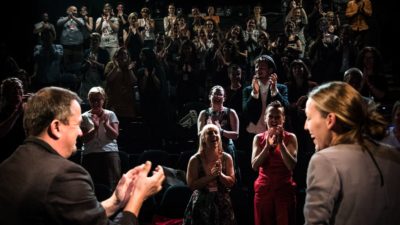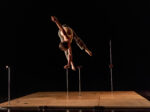Po úspěšném druhém ročníku konference v rámci projektu Circus and Its Others, kterou pořádal CIRQUEON – Centrum pro nový cirkus v Praze, projekt pokračuje tentokrát v kalifornském San Franciscu pod záštitou University of California, Davis v termínu od 12. do 15. listopadu 2020. Součástí konference bude i festival nového cirkusu a festival pouličního umění, které uspořádá Mondavi Center University of California.
Projekt Circus and its Others otevírá v kontextu cirkusových umění otázky, ve kterých se jejich řešitelé (akademici a akademičky i paktující umělci a umělkyně) zaměřují na to, co je považováno za „odlišné“ v současné (novo)cirkusové praxi. Do této jinakosti zahrnují otázky genderu, estetiky, performativity, postmoderní kultury, queer studies, tělesnosti i lidských fyzických a mentálních schopností.
Hlavními řečníky konference budou: Bojana Kunst (Institute for Applied Theatre Studies, Justus-Liebig University Gießen), André Lepecki (New York University’s Department of Performance Studies), Jane Nicholas (St. Jerome’s University, University of Waterloo) a Susan Nance (University of Guelph).
Cílem konference je spojit praktikující umělce (cirkusové artisty zabývající se uměleckým výzkumem), vědce a akademiky, aby se společně zamýšleli nad otázkami, které se týkají cirkusových umění v širokém
spektru témat (viz níže). Odborníci z celého světa tak budou moci poznávat odlišný kulturně-společenský kontext, v němž se cirkusová umění rozvíjejí.
Komunikačním jazykem konference bude angličtina, tudíž i výzvu k účasti na ni šíříme v anglickém jazyce. Návrhy dvacetiminutových konferenčních příspěvků (300-400 slov v anglickém jazyce) je možné
posílat do 15. dubna 2020 na email CircusOthersDavis2020@gmail.com. Pořadatelé žádají o finanční podporu pro konferenci, ale v tuto chvíli nemohou slíbit stipendia ani cestovní granty.
Návrh témat konference Circus and Its Others III, přičemž není nutné se omezovat pouze na ně:
Circus and Subjectivity
What questions can be asked about the relationship between virtuoso work/labour and circus in a neoliberal context? How is the contemporary subject already a circus artist (through the acts of juggling jobs, balancing work and life, the life journey as walking the tightrope, contorting to the demands of neoliberal paradigm, etc.), and what is the status of the circus professional amidst this profusion of metaphors? What questions can be asked about circus becoming a technology for self (Foucault), a site for
disidentification (Muñoz), or the undercommons (Moten/Harvey)?
Circus and Embodiment
What are the implications of shifts in the mainstreaming of contemporary circus and related changes in skill, artistry, and training for circus artists including those who may carry historical baggage of “born otherness” with them? What is required and expected of the bodies of today’s elite circus artists? How do circus trainers as well as circus artists deal with questions and meanings of body image?
Circus and Race
How has circus been implicated in the production of racial(ized) difference? Is circus white? Are there hidden histories about circus and its relation to race? How can circus studies engage with the Black radical tradition and other movements of resistance or protest?
Circus and Animal Studies
Has circus confused, reproduced, and/or problematized anthropological differences? How does circus engage with what might called zooësis, in terms proposed by Chaudhuri and Enelow as “the way culture makes art and meaning with the figure and body of the animal”?
Circus and Native American Studies / Circus and Indigeneity
What is circus’s relationship to Indigeneity? Are there stories of indigenous survival, sovereignty, and resurgence under the big top (and in other circus spaces)? What is the relationship between circus and colonialisms, including settler colonialism?
Circus and Feminism
In what ways does circus (historically and in the present) serve as a space of professional and personal empowerment for women? In what ways has circus reinforced gender norms that limit and objectify women? How are contemporary circus artists and companies creating work and professional circumstances that challenge and subvert gender binaries? How does intersectional feminism complicate questions of gender inclusion/exclusion?
Circus and Queer Studies
Where is the space for the queer in circus? What does the movement of certain circus practices into mainstream cultures mean for the presence of queer and alternative expression? Do celebrations and/or
exploitations of difference in certain circus practices carry particular meanings for queer performers or audiences? What is revealed through queer of color critique of circus norms?
Circus and Utopia
In the contemporary moment, what does it mean to run away with the circus? What are the alternative spaces created under the big top (and other circus spaces)? Can we glimpse, after Muñoz, a utopia of new communities, solidarities, and forms of resistance in our circus research and practice?
Circus and Science and Technology Studies
What connections are possible between circus and science? How does circus employ, explore, and exploit technologies? How can we understand circus as technology?
Social circus
What are the most recent currents of practice and inquiry in social circus? What are the power relations between social circus and professional circus, and how do questions of race/class/gender/ability figure in this?
Více informací najdete v přiloženém pdf:
Circus and its Others Davis 2020 CFP
foto: David Konečný



